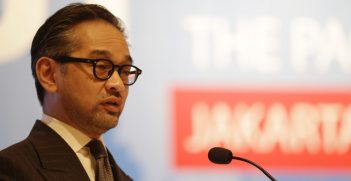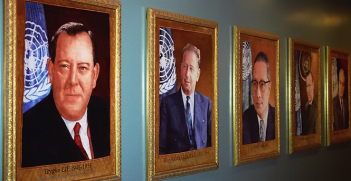Slaying Some Myths of Sovereignty and Intervention

The recent review of Luke Glanville’s Sovereignty and the Responsibility to Protect: A New History in Australian Outlook requires a response. Firstly, the responsibility to protect is not a “radical departure” from the previous absolutist conception of sovereignty, for no such conception existed.
Luke Glanville is deservedly acquiring an international reputation as a scholar who examines some of the major contemporary global developments through the lens of the history of Western political philosophy. If, in doing so, he helps to re-educate Western scholars about their own history of ideas, so much the better. Sarah Teitt, in her review of Glanville’s most recent major work for Australian Outlook, writes, “International relations experts and practitioners have tended to frame the responsibility to protect (R2P) principle as a radical departure from a long history of absolutist sovereignty that prevailed following the Peace of Westphalia in the mid-17th century until the 1990s.” Glanville’s book “upends this convention wisdom”.
I’d like to slay a few myths. The cottage industry of R2P scholarship and its remarkable normative advance in international policy originates in the 2001 report of the same title by the International Commission on Intervention and State Sovereignty (ICISS). I wrote the initial draft of the key chapters on sovereignty as responsibility. Thomas G. Weiss was research director for the ICISS and with colleagues wrote the supplementary volume. People who take the trouble to read the ICISS report, the supplementary research volume, and the writings of Weiss and myself before and since would never make the mistake of saying any of us subscribed to an ‘absolutist’ conception of sovereignty. To that end, let me restate three arguments that can be found in these collected works.
Sovereignty has never been absolute
We have noted qualifications to, limitations of, and restrictions on sovereignty along four separate dimensions: legal vs. political sovereignty; national vs. constitutional sovereignty; state vs. popular sovereignty; and sovereignty constrained by international law, norms and codes of conduct.
Sovereignty is the foundational principle upon which the contemporary world order rests. The principle of non-intervention is the most important embodiment of the notion that states are autonomous entities; its ancestry too can be traced back to the Treaty of Westphalia (1648). Subsequently, however, sovereignty was redefined in terms of a social contract between citizens and rulers. Violations of the contract by the rulers voided the duty of the citizens to obey the commands of the sovereign. By the end of the 19th century a distinction had been drawn between legal sovereignty, as vested in parliament, and political sovereignty, as vested in the electorate. In the 20th century, the trend was taken further with the notion of popular sovereignty, which was conceived initially as consent and subsequently as active choice of the citizens. This was endorsed by UN Secretary-General Kofi Annan in 1999.
National sovereignty locates the state as the ultimate seat of power and authority, unconstrained by internal or external checks; constitutional sovereignty holds that the power and authority of the state are not absolute but contingent and constrained. Domestically, power-sharing between the executive, legislature and judiciary, at federal and provincial levels, is regulated by constitutional arrangements and practices. Internationally, states are constrained by globally legitimated institutions and practices. The UN Charter itself contains an inherent tension between the intervention-proscribing principle of state sovereignty and the intervention-prescribing principle of human rights. By signing the UN Charter, a country accepts collective obligations and international scrutiny.
Sovereignty, far from being absolute, has thus generally been considered contingent. The more significant change of recent times is that it has been reconceived as being instrumental. Its validation rests not in a mystical reification of the state, but in its utility as a tool for the state, serving the interests of the citizens. Internal forms and precepts of governance must conform to international norms and standards of state conduct. That is, sovereignty must be exercised with due responsibility. This redefinition of sovereignty as responsibility was the conceptual foundation stone of the articulation of the new norm of the responsibility to protect.
Long history of interventions
Similarly, our combined published work indicates awareness of the long history of ‘humanitarian intervention’, the use of force justified by the need to protect victims of persistent, arbitrary abuses by their own governments. Scholars have rightly traced the roots of sovereignty as responsibility to the works of Roberta Cohen and Francs Deng at Brookings Institution in the mid-1990s. But in terms of the core ideas that make up R2P, at least as important a source of ancestry is an article I published in 1990. This was written after the military coups in Fiji and asked who, and on what grounds, would have the responsibility or could claim a right to intervene to protect Fijian Indians should they be attacked in large numbers (mercifully the situation never deteriorated to that point). Because the article was published in a New Zealand journal, and one of the gravest defects of academic scholarship is that value is judged by where an article is published and not its quality of analysis, that article has been largely forgotten.
In that article, I identified at least 11 justifications that were used during the Cold War to legitimise a string of interventions by various countries. The crucial point is that all were contested in principle and controversial in practice.
Promoting absolutist sovereignty
The push to absolutist sovereignty and non-intervention was led by developing countries after 1945, with good reason. In the era of decolonisation after 1945, the sovereign equality of states and the norm of non-intervention received their most emphatic affirmations from the newly independent states whose attachment to sovereignty is deeply emotional. The most important clue to understanding their concerns is the history of Europe’s encounter with Arabs, Africans and Asians. They need no reminding that they were colonised at the height of the Westphalian order of sovereign statehood.
As I put it in my book in 2006:
‘They’ (the European colonisers) came to liberate ‘us’ (the colonised natives) from our local tyrants and stayed to rule as benevolent despots. In the name of enlightenment, they defiled our lands, plundered our resources and expanded their empires… Should we be mute accomplices when they substitute their mythology of humanitarian intervention for our narratives of colonial oppression?
The language of humanitarian intervention was resurrected by NATO to justify intervention in Kosovo in 1999. As Ted Carpenter reminds us, the fears and warnings of the grave destabilising precedent that NATO was setting have been amply vindicated in the years since. The fierceness of the criticism from the developing countries was the background to Annan’s call for a new normative consensus, the setting up of ICISS by the Canadian government, and the articulation of R2P, influenced by the twin outliers of unauthorised NATO intervention in Kosovo and the earlier international failure to intervene in the Rwandan genocide in 1994.
Ramesh Thakur is a former United Nations assistant secretary-general and a professor in the Crawford School of Public Policy at the Australian National University.
This article was submitted in response to the review of Luke Glanville’s book, ‘Sovereignty and the Responsibility to Protect: A New History’ published on 16 May 2017.
This article is published under a Creative Commons Licence and may be republished with attribution.





